I have a query something like this. It has an execution plan using an index that I expect, up until the amount of data (i.e. the number of characters) returned by the SELECT goes over a boundary. At that point, the plan no longer uses the index and the query gets 100+ times slower.
If I use NVARCHAR(203), it is fast. NVARCHAR(204) is slow. Also, when it does not use the index, it totally burns up the CPU. At least it seems to me to be a data size problem, but I am looking for any insight.
I have changed oldValueString and newValueString to NVARCHAR(255) and things are a little better, but I still can't query all of the columns w/o losing the index in the plan.
SELECT
[Lx_AuditColumn].[auditColumnPK],
CONVERT(NVARCHAR(204), [Lx_AuditColumn].[newValueString])
FROM
[dbo].[Lx_AuditColumn] [Lx_AuditColumn],
[dbo].[Lx_AuditTable] [Lx_AuditTable]
WHERE
[Lx_AuditColumn].[auditTableFK] = [Lx_AuditTable].[auditTablePK]
AND
[Lx_AuditTable].[createdDate] >= @P1
AND
[Lx_AuditTable].[createdDate] <= @P2
ORDER BY
[Lx_AuditColumn].[auditColumnPK] DESC
This is the basic structure of tables (I eliminated some indexes and FK constraints).
CREATE TABLE [dbo].[Lx_AuditTable]
(
[auditTablePK] [int] NOT NULL IDENTITY(1, 1) ,
[firmFK] [int] NOT NULL ,
[auditMasterFK] [int] NOT NULL ,
[codeSQLTableFK] [int] NOT NULL ,
[objectFK] [int] NOT NULL ,
[projectEntityID] [int] NULL ,
[createdByFK] [int] NOT NULL ,
[createdDate] [datetime] NOT NULL ,
CONSTRAINT [Lx_PK_AuditTable_auditTablePK] PRIMARY KEY CLUSTERED
(
[auditTablePK]
) WITH FILLFACTOR = 90
)
GO
CREATE INDEX [Lx_IX_AuditTable_createdDatefirmFK]
ON [dbo].[Lx_AuditTable]([createdDate], [firmFK])
INCLUDE ([auditTablePK], [auditMasterFK])
WITH (FILLFACTOR = 90, ONLINE = OFF)
GO
CREATE TABLE [dbo].[Lx_AuditColumn]
(
[auditColumnPK] [int] NOT NULL IDENTITY(1, 1) ,
[firmFK] [int] NOT NULL ,
[auditTableFK] [int] NOT NULL ,
[accessorName] [nvarchar] (100) NOT NULL ,
[dataType] [nvarchar] (20) NOT NULL ,
[oldValueNumber] [int] NULL ,
[oldValueString] [nvarchar] (4000) NULL ,
[newValueNumber] [int] NULL ,
[newValueString] [nvarchar] (4000) NULL ,
[newValueText] [ntext] NULL ,
CONSTRAINT [Lx_PK_AuditColumn_auditColumnPK] PRIMARY KEY CLUSTERED
(
[auditColumnPK]
) WITH FILLFACTOR = 90 ,
CONSTRAINT [Lx_FK_AuditColumn_auditTableFK] FOREIGN KEY
(
[auditTableFK]
) REFERENCES [dbo].[Lx_AuditTable] (
[auditTablePK]
)
)
GO
CREATE INDEX [Lx_IX_AuditColumn_auditTableFK]
ON [dbo].[Lx_AuditColumn]([auditTableFK])
WITH (FILLFACTOR = 90, ONLINE = OFF)
GO
Good:

Bad:

`) in Code Snippets. Read [Editing help](http://stackoverflow.com/editing-help) before writing a question. – Himanshu Aug 24 '12 at 10:07